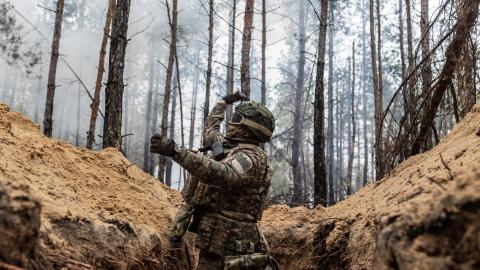Below Hudson Senior Fellow Can Kasapoğlu offers a military situation report about the war in Ukraine.
1. Battlefield Assessment
The Ukrainian Armed Forces remain on the defensive while the Russian military is pursuing a costly offensive campaign designed to take advantage of favorable force-to-terrain and force-on-force ratios. Russian units are advancing on Avdiivka despite mounting material and personnel losses. Unchecked, these advances could produce a decisive outcome in a matter of weeks.
Fighting also has continued near Kupiansk, although open-source intelligence confirms that neither side has attained strategic gains. On the Bakhmut front, both sides traded marginal gains this week following limited positional clashes. In the south, Ukrainian defenses remained strong, denying any large-scale push by the Russian military.
The Ukrainian bridgeheads across the Dnipro River remained stable, though these tactical footholds lack brigade-size follow-on units to support any meaningful offensive action. Nonetheless, Russian combat formations have been unable to disrupt Ukraine’s tactical gains across the bridgehead.
In this conflict, artillery continues to drive the fighting. Drone warfare assets, from loitering munitions to first-person-view (FPV) drones, remain a significant feature of the war. Russian drone assaults employing Iran’s Shahed drone baseline have continued; as per reports by Ukrainian officials, last week Russia launched a five-hour drone assault against population centers in regions including Kharkiv and Dnipro. According to the announcement, Ukrainian air defenses successfully intercepted most of the Shahed UAVs involved in the attack. But evidence suggests that the joint Russia-Iran drone plant in Tatarstan is producing at prolific rates.
Over the last week, Ukraine continued to conduct successful assaults against high-value Russian assets, including a drone strike on February 9 in which Ukrainian forces struck and damaged two oil refineries in Krasnodar Krai. Kyiv’s decision to target Moscow’s energy generation capabilities is no coincidence given Russia’s ongoing power outages and restricted energy supply. Ukraine’s long-range strike programs, centered on loitering munitions and missile warfare systems, are of critical value amidst the deadlock in conventional warfare. To sustain these capabilities, Kyiv’s Ministry of Digital Transformation has to play a crucial role.
2. Avdiivka May Fall
Open-source defense intelligence confirms that the Russian offensive has attained significant gains around Avdiivka, which is at serious risk of falling into Russia’s hands. According to Ukrainian sources, Russian combat formations registered alarming advances north of the city, while expanding their foothold across the local rail line. Russian news outlets also claimed that Russian forces advanced in the direction of the Avdiivka Coke Plant, a critical position in the fighting.
With fewer than 1,000 residents remaining in the city, Avdiivka has seen enormous destruction during a challenging siege. Despite their success, the push for the city has also been highly attritional for the Russian Armed Forces, which have lost 10 percent of their combat-deployed tanks.
Located in the industrial Donbas, Avdiivka has been a critical impediment to Russia’s efforts to occupy the remaining parts of Donetsk and Luhansk Oblasts, which the Kremlin has ostensibly annexed but has been unable to seize. Should the city fall, Russian forces would no doubt continue their march.
3. General Syrskyi Replaces General Zaluzhnyi
Last week, Ukrainian President Volodymyr Zelenskyy appointed a new commander-in-chief for the Armed Forces of Ukraine, replacing General Valerii Zaluzhnyi with General Oleksandr Syrskyi.
Known as the “Iron General,” Zaluzhnyi was born in 1973, and completed his military education at the National Defense University of Ukraine and the Odesa Military Academy before attaining the rank of four-star general. Before leaving his post to Syrskyi, Zaluzhnyi led the Armed Forces of Ukraine from July 2021 until February 2024.
From an older generation, General Oleksandr Syrskyi was born in 1965 in Vladimir Oblast in the former Soviet Union. Prior to joining the Soviet Artillery Corps, Syrskyi completed his military education at the Moscow Higher Military Command School. Previously the leader of Ukraine’s ground forces, Syrskyi has played an important role in the Ukrainian Armed Forces since 2019, leading the nation’s Joint Forces Operation from May to August of that year. He also oversaw Ukraine’s success in the defense of Kyiv and in the 2022 Kharkiv counteroffensive.
However, Syrskyi reportedly is far from popular among some Ukrainian troops, many of whom are critical of his military decisions in Bakhmut, where Ukraine suffered a heavy death toll before eventually losing the city to Russia.
In a Telegram announcement, General Syrskyi reported that the well-being of Ukrainian soldiers and a careful recalibration of the country’s strategy in the war will be his priorities. Only time will tell whether he will be able to deliver the fresh approach to the battlefield for which President Zelenskyy hopes.




















